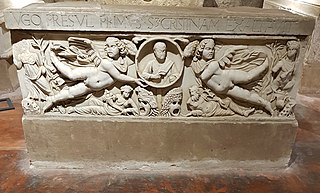Related Research Articles

Roger II was King of Sicily and Africa, son of Roger I of Sicily and successor to his brother Simon. He began his rule as Count of Sicily in 1105, became Duke of Apulia and Calabria in 1127, then King of Sicily in 1130 and King of Africa in 1148.

RobertGuiscard, sometimes Robert "the Guiscard", also nicknamed “Terror Mundi” was a Norman adventurer remembered for the conquest of southern Italy and Sicily.

Tancred was King of Sicily from 1189 to 1194. He was born in Lecce an illegitimate son of Roger III, Duke of Apulia by his mistress Emma, a daughter of Achard II, Count of Lecce. He inherited the title "Count of Lecce" from his grandfather and is consequently often referred to as Tancred of Lecce. Due to his short stature and unhandsome visage, he was mocked by his critics as "The Monkey King".
William I, called the Bad or the Wicked, was the second king of Sicily, ruling from his father's death in 1154 to his own in 1166. He was the fourth son of Roger II and Elvira of Castile.

Constance I was reigning Queen of Sicily from 1194–98, jointly with her spouse from 1194 to 1197, and with her infant son Frederick II, Holy Roman Emperor, in 1198, as the heiress of the Norman kings of Sicily. She was also Holy Roman Empress and later Dowager by marriage to Henry VI, Holy Roman Emperor.

The Kingdom of Sicily was a state that existed in the south of the Italian Peninsula and for a time the region of Ifriqiya from its founding by Roger II of Sicily in 1130 until 1816. It was a successor state of the County of Sicily, which had been founded in 1071 during the Norman conquest of the southern peninsula. The island was divided into three regions: Val di Mazara, Val Demone and Val di Noto.
Richard Drengot was the count of Aversa (1049–1078), prince of Capua and duke of Gaeta (1064–1078).

Jordan I, count of Aversa and prince of Capua from 1078 to his death, was the eldest son and successor of Prince Richard I of Capua and Fressenda, a daughter of Tancred of Hauteville and his second wife, also named Fressenda, and the nephew of Robert Guiscard, duke of Apulia, Calabria, and Sicily. He, according to William of Apulia, "equalled in his virtues both the duke and his father."

Robert II was the count of Aversa and the prince of Capua from 1127 until his death.

Alfonso, also called Anfuso or Anfusus (c. 1120 – 10 October 1144), was the Prince of Capua from 1135 and Duke of Naples from 1139. He was an Italian-born Norman of the noble Hauteville family. After 1130, when his father Roger became King of Sicily, he was the third in line to the throne; second in line after the death of an older brother in 1138. He was the first Hauteville prince of Capua after his father conquered the principality from the rival Norman Drengot family. He was also the first Norman duke of Naples after the duchy fell vacant on the death of the last Greek duke. He also expanded his family's power northwards, claiming lands also claimed by the Papacy, although he was technically a vassal of the Pope for his principality of Capua.
Roger III was the eldest son of King Roger II of Sicily and Elvira of Castile. He was the Duke of Apulia from 1134 until his death.

The Hauteville was a Norman family originally of seigneurial rank from the Cotentin. The Hautevilles rose to prominence through their part in the Norman conquest of southern Italy. By 1130, one of their members, Roger II, was made the first King of Sicily. His male-line descendants ruled Sicily until 1194. Some Italian Hautevilles took part in the First Crusade and the founding of the Principality of Antioch (1098).

Andrew, count of Rupecanina, was a Norman nobleman of the Mezzogiorno. He was a longtime adversary of the royal power.

Hugh was the Archbishop of Capua in the late 1140s and Archbishop of Palermo from 1150 until his death, probably in 1165–66.
The Treaty of Mignano of 1139 was the treaty which ended more than a decade of constant war in the Italian Mezzogiorno following the union of the mainland duchy of Apulia and Calabria with the County of Sicily in 1127.
The Drengots were a Norman family of mercenaries, one of the first to head to Southern Italy to fight in the service of the Lombards. They became the most prominent family after the Hautevilles.

The Principality of Capua was a Lombard state centred on Capua in Southern Italy, usually de facto independent, but under the varying suzerainty of Holy Roman and Eastern Roman Empires. It was originally a gastaldate, then a county, within the principality of Salerno.

The Norman conquest of southern Italy lasted from 999 to 1139, involving many battles and independent conquerors.
Events during the year 1156 in Italy.
Swabian Sicily denotes the period in the history of Sicily during which it was ruled by the Hohenstaufen dynasty, lasting from Henry VI's's accession to the island's throne in 1194 until Manfred of Sicily's defeat by Charles I of Anjou in 1266. It has been particularly researched by German scholars such as Ernst Kantorowicz and Willy Cohn.
References
- 1 2 3 Chalandon 1968, p. 193.
- 1 2 Robinson 2015, p. 378.
- ↑ Robinson 1990, p. 147.
- ↑ Dummett 2015, p. 49.